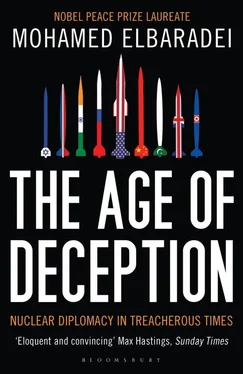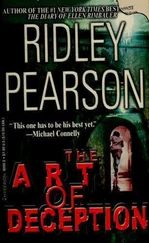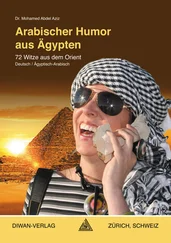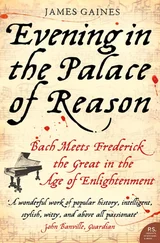Most disturbingly, on A. Q. Khan’s most recent visit to Tripoli, he had brought two white shopping bags bearing the name of a Karachi tailor, which contained the designs for a nuclear weapon. “You might need this in the future,” Khan had reportedly told Matouq. Since then, Matouq said, the “Good Looks Tailor” bags had been in his safe.
I was stunned by the extent of Libya’s clandestine nuclear activities, as Matouq portrayed them. But my mind was also racing on a parallel track, analyzing the extent to which the Agency was poised to learn about all these activities through inspection, since Libya was party to the NPT.
For nine months, according to Matouq, Libya had been engaged with British and American officials negotiating a deal under which the Libyan government would give up its WMD programs. “We wanted to inform the Agency all along,” Matouq said, “but they wouldn’t allow it.” I bristled but said nothing.
The next day, representatives from the U.S. and U.K. intelligence agencies came to see me at home. I was angry, and I let my indignation show. “What is not clear about your legal obligations under the NPT?” I asked them. “Libya, the United States, and the United Kingdom are all three members of the Treaty. When you discover that a member is in violation of its nuclear safeguards agreement, you are legally obligated to inform the inspecting organization, the IAEA, so that we can take action.”
They made no argument in response. Shortly after the meeting, Jack Straw called from London to say that only three or four people in the British government had been privy to the information; he apologized that I had not been informed. Colin Powell called with much the same message: they had kept the information extremely restricted, he said, because of uncertainty about the outcome of the negotiations. They did not want to be embarrassed if their efforts backfired.
Powell’s explanation made little sense to me. Later, I heard from an official in MI6 that the real reason for the extreme secrecy governing the Libyan negotiations was to protect the talks from U.S. hard-liners. The fear, I was told, was that they might have tried to torpedo a peaceful resolution of the Libyan case. So they were informed only when the deal was done.
I decided to make the best of the situation and go immediately to Libya. With a small group of IAEA experts, I flew to Tripoli for a few days between Christmas and the New Year. We were taken by our Libyan counterparts to a series of warehouses where nuclear equipment was stored. The scale of the program was small. We were told they had begun installing a few small centrifuge cascades for testing purposes, but only one—a cascade of just nine centrifuges—was actually complete, with electrical and process equipment hooked up. None of the centrifuges had been tried with nuclear material. The Libyans said they had not yet begun constructing an industrial-scale facility nor any of the associated infrastructure. Nor did they have a functioning weaponization program.
All told, it appeared they had about twenty complete centrifuges and components for two hundred more of the P-1 design, the first-generation Pakistani model we had seen in Iran. They had ordered ten thousand of the more advanced P-2 centrifuges; however, many of the P-2 components, including essential rotors, had not yet been delivered. [3] The rotor is the cylindrical hollow core of a centrifuge through which the uranium feedstock flows. Because these rotors must spin at extremely high speeds for long periods of time, they require high-precision manufacturing and advanced materials to withstand the resultant stresses.
Apparently, A. Q. Khan had tried to have the rotors manufactured by a South African company, and when that effort failed, he had turned to a Malaysian firm. But at the time Libya revealed its program, the rotors had still not been manufactured.
Briefing the press on what we had seen, I characterized the stage of the Libyan program as nascent. Nonetheless, I was worried. The uranium conversion equipment had been assembled methodically and thoughtfully in a modular pattern, evidence of the sophisticated outside assistance the Libyans had received. This modular aspect was especially disquieting; it had the appearance of a sort of “nuclear do-it-yourself kit.” The designer, whoever it was, seemed to have ease of replication in mind.
Only a small group had been privy to the transactions with the Khan network—although we heard many opinions, and rumors were abundant. Except for the actual interlocutors, very few senior Libyan officials knew how much Khan had received for his products and services.
The distressing question plaguing us all was simple: “Who else?” What other customers had gone shopping at this underground nuclear supply chain?
While in Libya, I was invited to meet Colonel Muammar al-Gaddafi, Leader of the Revolution. The meeting took place at the Bab al-Azizia military barracks in the middle of Tripoli. I waited in a chilly room near the entrance, glad I was wearing my coat. Bashir Saleh Bashir, one of Gaddafi’s closest assistants, came to greet me and reiterate the government’s promise of full cooperation. A short time later, the foreign minister, Abd al-Rahman Shalgem, appeared and invited me inside.
I was ushered into a large heated library. There was little furniture, just a big desk in front of rows of bookshelves holding a meager scattering of books in Arabic. Colonel Gaddafi, seated behind the desk in a traditional robe, invited Shalgem and me to take the chairs facing him. The ambience of the meeting matched the Spartan look of the place.
Gaddafi was more soft-spoken than I expected, his manner an odd mix of friendliness and reserve. His opening line was memorable: “I don’t know how to put this,” he said, “but why does the Egyptian government hate you?” He added quickly, “The Egyptians are claiming that they can help us get rid of our weapons program better than you and your IAEA colleagues can.”
Gaddafi then asked whether I was a Nasserite. “You grew up during Nasser’s time in Egypt,” he said. “You must be a Nasser fan.”
“I am not,” I answered, probably to his disappointment, since Nasser was reportedly his idol. “Nasser had a very good vision and set of principles,” I added, “but much of it failed in its implementation.”
Gaddafi launched into a soliloquy on his decision to terminate his WMD programs. He had reached the conclusion that weapons of mass destruction would not add to Libya’s security. They should be gotten rid of, he declared, not only in Libya but also in the Middle East and globally. Of course, I heartily agreed.
Gaddafi digressed. He spoke glowingly about Libya’s place in world affairs, anecdotes that were not in all cases admirable. “This little Libya,” he said proudly, referring to his country’s record of influencing world events.
I realized that Gaddafi was less than fully informed on global security alliances and structures. When I described, for example, the NATO nuclear umbrella that protects its members, Gaddafi pulled out a pencil and a little notebook and began to take notes. But he spoke earnestly of his desire to develop Libya: he wanted better infrastructure; he wanted more roads; he wanted Libyan students to receive scholarships to Western universities; he wanted his country to advance in the fields of science and technology. He asked if I could help to impress these points on George Bush and Tony Blair.
He also urged me to speak publicly about Libya as an example that should lead to a Middle East free from weapons of mass destruction. I assured him again that I was an advocate of a nuclear-weapons-free Middle East. I also agreed to speak to my American and British contacts about supporting Libya economically. And in fact I followed through on this point with Jack Straw and a number of American officials, who said they planned to be responsive to Libya’s needs. It would be to everyone’s advantage, they felt, if Libya were to improve its financial and economic condition and normalize its relations with the global community.
Читать дальше












